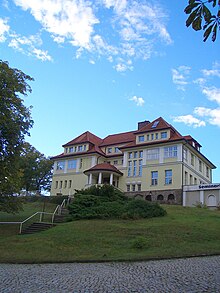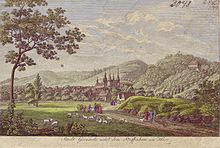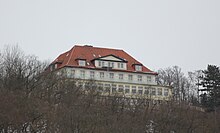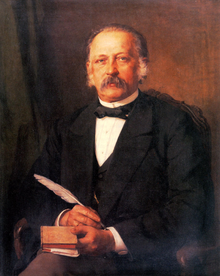Hotel Stubenberghaus
The Hotel Stubenberghaus is a listed building in the town of Gernrode, part of the town of Quedlinburg in Saxony-Anhalt .
location
It is located at the address Stubenberg 1 on the edge of the Herrenberg , which rises south of the Gernröder old town on the northern edge of the Harz Mountains and is registered as a hotel in the local monument register.
architecture
The two-story, plastered building, for which the term Stubenberg or Hotel Stubenberg is often used, goes back to a building erected in 1754 by Prince Victor Friedrich von Anhalt-Bernburg as a hunting and pleasure house and has three wings. In 1914/15 an extensive renovation took place, whereby the original cubature was largely retained. The house rises over from granite -built basement . Covered with it by a Zwerchhäusern provided hipped roof .
At the rear there is a covered staircase that is designed in the shape of a belvedere .
The interior of the house is partially preserved in the neoclassical style, especially in the decoration of the hall and the stairs.
history
In the place of the Stubenberghaus there was a meadow slope with fruit trees and benches at the top of the Herrenberg. Game master and chief forester Döbel celebrated the birthday of Prince Friedrich von Anhalt of Gernrode every year with forest workers . The idea arose to replace the benches with a guest house. From 1754 to 1756, Prince Victor Friedrich had the top of the Herrenberg leveled and a mansion built there. The result was a kind of log house , which was equipped with a carousel , swings and a bowling alley and was initially called a step mountain . It was then expanded into a hotel and leased out. The first tenant was a Mr. Kersten. In 1779 the Gernröder Schützengesellschaft set up a shooting range . For a long time between Whitsun and Michaelmas shooting exercises were carried out on Sundays. In 1847 the rifle guild relocated their shooting range, located at the “Zur Rose” inn , to the Stubenberg.
The house was also regularly used to hold court festivals for the Anhalt ruling house. Such festivals are documented for 1780 and 1783, among others. At the beginning of the 19th century, the building was also known as the manor house. It was considered stately, but was leased and was described as a place of fun and relaxation for the whole area and the first house on the square, on which parties and entertaining games took place on Sundays, but also almost every other day of the week. In 1867 the property passed from the personal property of the Duke to that of the state, the Duchy of Anhalt .
During the Franco-Prussian War of 1870/71 , several hundred French prisoners of war were housed on the Stubenberg after they had previously lived in Quedlinburg. It is said that Gernröder children and young people, including the later well-known sinologist Otto Franke, were in friendly contact with the prisoners and that cigarettes and fruit were exchanged for uniform buttons and blankets.
On April 11, 1885, the decision to build the Selketalbahn was made on the Stubenberg .
In 1890 a memorial stone was placed on the Stubenberg to commemorate Otto von Bismarck's visit in 1846 . The stone was removed in 1945 and used to build roads. In 1907 the shooting range on the Stubenberg was dismantled and moved to the Gernröder Stadtpark. As early as 1903, the rifle guild had moved from Stubenberg to the Am Osterberg area closer to the city.
In the end, the original building no longer appeared befitting and was replaced by the current building in 1914–1915. The inauguration of the modern, state-owned panorama hotel took place in 1915. The hotel remained open to the public until 1945. However, during times when Gauleiter Rudolf Jordan was staying here, the facility was closed to the general public.
In 1945 the hotel was looted. In 1945 it served initially as the city headquarters of the US occupation forces and from 1945 to 1947 to accommodate those displaced from Silesia . In the years 1947/1948 the Stubenberghaus was renovated and one of the first in 1948 FDGB - Holiday homes opened. Later the restaurant of the house was again open to the public.
In 1974 the Stubenberghaus was renovated and in 1984 a ward building was redesigned. In 1990 the management of the property was taken over by the Treuhandanstalt . She closed the home and looked for a buyer for the property. On September 8, 1992 Eckhardt Müller, a former resident of Gernrode, acquired the Stubenberghaus. This was followed by renovation of the property in two construction phases from 1992 to 1995 and on July 21, 1995 the panorama hotel with terrace and beer cellar was reopened . However, the owner ran into financial difficulties. The Stubenberghaus was up for auction on May 16, 2002, but without success. On November 4, 2002, Eckhardt Müller gave up the house due to bankruptcy . On November 24, 2002, Horst Lischke and Astrid Brußmann started seminars in the building. The leased property was fenced in and was therefore no longer accessible to the general public. Attempts to operate the house again as a public restaurant initially failed. In 2004 the seminar business was stopped again for financial reasons and the property was placed under compulsory administration.
The 250th anniversary celebrations took place on August 27, 2004 on the Stubenberg, but the hotel was still empty and suffered damage from vandalism . In August 2011, Henry Keilwitz and Christine Rönsch from Ballenstedt took over the house and renovated it. The new opening of the Panoramahotel took place on December 2nd, 2012.
Personalities
The exposed location of the house on the edge of the Harz Mountains high above the Harz foreland made the building a popular excursion destination. A visit to the Stubenberghaus is documented for a large number of celebrities.
Prince Friedrich von Anhalt held a festival on the Stubenberg as early as 1756 . In 1762 the poets Johann Wilhelm Ludwig Gleim and Friedrich Gottlieb Klopstock migrated to the Stubenberg. In 1782 Gleim held a genius congress here. Herr von der Assenburg dined with members of the court on November 24, 1780 on the Stubenberg. In 1783 the reigning prince dined with young people every Wednesday in the estate.
In 1792 the poet Johann Ludwig Tieck took a break on the Stubenberg during a sunrise . The poet and naturalist Friedrich Freiherr von Hardenberg stayed at the Stubenberg several times. The well-known painter Caspar David Friedrich returned to Stubenberg for a break in 1795. In 1797, the poet Heinrich von Kleist and a friend climbed the Stubenberg in the dark shortly after midnight and watched the sunrise from here. He described his experiences in a letter. The visit is said to have taken place while the trees were in bloom. The guitar was played enthusiastically .
On August 15, 1805, Johann Wolfgang von Goethe and his son August von Thale visited the Stubenberg by coach via Suderode and stopped there before traveling on to Ballenstedt Castle . In a letter dated August 28th to Duke Carl August von Weimar , he reported about Stubenberg with the words: “He awakened an uplifting and happy mood in me.” On September 10th of the same year Joseph von Eichendorff stayed with his brother Wilhelm von Eichendorff and a servant in the dining room. The so-called birch water was drunk. He later processed the impressions in his 1833 novella Much Ado About Nothing . On September 8, 2005, an Eichendorff memory hike also led over the Stubenberg.
In 1820 the composer Carl Maria von Weber and his wife took part in a shooting festival on the Stubenberg. The family of the composer Felix Mendelssohn Bartholdy held family get-togethers in Stubenberg several times from 1820 onwards.
In 1824 one of Heinrich Heine's Harz hikes led from the Bodetal to Mägdesprung over the Stubenberg. The Danish writer Hans Christian Andersen visited the Stubenberg in 1831, following Goethe's Harz trip. The doctor Wilhelm von Blumenhagen (1781–1839) was one of the guests of the hotel and described his experiences positively in the book Walks through the Harz , published in 1838 . In 1838 the painter Ludwig Richter made a steel engraving depicting the Stubenberg after visiting it on a hike.
Around 1838 the art historian Ludwig Puttrich also came to the Stubenberg inn. Theodor Fontane visited the house several times . In his work My Childhood he described his impressions on the occasion of his visit in 1842. Another stay is documented for at least 1884.
Prince Otto von Bismarck stayed with his future wife Johanna von Puttkamer on August 2, 1846 on the Stubenberg. At times a memorial stone commemorated this visit.
On May 23, 1847, Pentecost Sunday , the court painter and conductor Wilhelm von Kügelgen visited the house he called the Step Mountain and later described the experience euphorically in his book Memoirs of the Old Man . However, von Kügelgen was a guest before. In 1840 he was with his pupil Caroline Bardua and the singer Wilhelmine Bardua , in 1842 with the painter Ludwig Richter on the Stubenberg. On May 5, 1863, Kügelgen visited the Stubenberg together with Philipp von Nathusius . An excursion by Duke Alexander Carl von Anhalt-Bernburg (1805–1863) with his wife Friederike von Anhalt-Bernburg , Wilhelmine Bardua and Mr. von Kramer on June 24, 1847 has been handed down. The company traveling in a carriage drank in a pavilion in the Stubenberg Tea.
The later Gernröder clergyman and local writer Hans Hartung first visited the house on the occasion of a school trip in 1887.
The local poet Kaethe Schulken (1891–1974) published the poem Auf dem Stubenberg in her book Blue Mountains in the Distance , published in 1938 .
literature
- Rosemarie and Gerhard Kellermann: The Stubenberg in Gernrode (East Harz) . Gernrode 2013.
- State Office for the Preservation of Monuments of Saxony-Anhalt (Ed.): List of monuments in Saxony-Anhalt. Volume 7.2: Falko Grubitzsch, with the participation of Winfried Korf and Theo Gosselke: Quedlinburg district. Halle 2007, ISBN 978-3-86568-072-3 , p. 127.
Web links
Individual evidence
- ↑ State Office for the Preservation of Monuments in Saxony-Anhalt (ed.): List of monuments in Saxony-Anhalt. Volume 7.2: Falko Grubitzsch, with the participation of Winfried Korf and Theo Gosselke: Quedlinburg district. Halle 2007, ISBN 978-3-86568-072-3 , p. 127.
- ↑ a b Rosemarie and Gerhard Kellermann: The Stubenberg in Gernrode (East Harz) . Gernrode 2013, p. 3.
- ^ Rosemarie and Gerhard Kellermann: Chronicle of the City of Gernrode . Gernroder Kulturverein Andreas Popperodt eV, Gernrode 2013, p. 38.
- ^ Rosemarie and Gerhard Kellermann: The Stubenberg in Gernrode (East Harz) . Gernrode 2013, p. 2.
- ^ Rosemarie and Gerhard Kellermann: The Stubenberg in Gernrode (East Harz) . Gernrode 2013, p. 58.
- ^ Rosemarie and Gerhard Kellermann: The Stubenberg in Gernrode (East Harz) . Gernrode 2013, p. 27.
- ^ Rosemarie and Gerhard Kellermann: Chronicle of the City of Gernrode . Gernroder Kulturverein Andreas Popperodt eV, 2013, p. 49.
- ^ Friedrich Gottschalck , pocket book for travelers in the Harz , G. Th. Keil, Magdeburg 1806; Reprint, 3rd edition 2015, Schmidt-Buch-Verlag Wernigerode, ISBN 978-3-936185-69-0 , page 177 f.
- ^ Rosemarie and Gerhard Kellermann: The Stubenberg in Gernrode (East Harz) . Gernrode 2013, p. 12.
- ^ Rosemarie and Gerhard Kellermann: The Stubenberg in Gernrode (East Harz) . Gernrode 2013, p. 42.
- ↑ a b Rosemarie and Gerhard Kellermann: The Stubenberg in Gernrode (East Harz) . Gernrode 2013, p. 24 f.
- ^ Rosemarie and Gerhard Kellermann: Chronicle of the City of Gernrode . Gernroder Kulturverein Andreas Popperodt eV, 2013, p. 56 f.
- ^ Rosemarie and Gerhard Kellermann: Chronicle of the City of Gernrode . Gernroder Kulturverein Andreas Popperodt eV, 2013, p. 147.
- ^ Rosemarie and Gerhard Kellermann: The Stubenberg in Gernrode (East Harz) . Gernrode 2013, p. 59 f.
- ^ A b Rosemarie and Gerhard Kellermann: Chronicle of the City of Gernrode . Gernroder Kulturverein Andreas Popperodt eV, 2013, p. 144.
- ^ Rosemarie and Gerhard Kellermann: The Stubenberg in Gernrode (East Harz) . Gernrode 2013, p. 22 f.
- ^ Rosemarie and Gerhard Kellermann: The Stubenberg in Gernrode (East Harz) . Gernrode 2013, p. 44 f.
- ^ Rosemarie and Gerhard Kellermann: The Stubenberg in Gernrode (East Harz) . Gernrode 2013, p. 10.
- ^ Rosemarie and Gerhard Kellermann: The Stubenberg in Gernrode (East Harz) . Gernrode 2013, p. 48 f.
- ^ Rosemarie and Gerhard Kellermann: The Stubenberg in Gernrode (East Harz) . Gernrode 2013, p. 28 f.
- ^ Rosemarie and Gerhard Kellermann: Chronicle of the City of Gernrode . Gernroder Kulturverein Andreas Popperodt eV, Gernrode 2013, p. 42.
- ^ A b Rosemarie and Gerhard Kellermann: Chronicle of the City of Gernrode . Gernroder Kulturverein Andreas Popperodt eV, Gernrode 2013, p. 44.
- ^ Rosemarie and Gerhard Kellermann: The Stubenberg in Gernrode (East Harz) . Gernrode 2013, p. 14 f.
- ^ Rosemarie and Gerhard Kellermann: The Stubenberg in Gernrode (East Harz) . Gernrode 2013, p. 30 f.
- ^ Rosemarie and Gerhard Kellermann: The Stubenberg in Gernrode (East Harz) . Gernrode 2013, p. 50 f.
- ^ Rosemarie and Gerhard Kellermann: The Stubenberg in Gernrode (East Harz) . Gernrode 2013, p. 6 f.
- ^ Rosemarie and Gerhard Kellermann: The Stubenberg in Gernrode (East Harz) . Gernrode 2013, p. 34 f.
- ^ Rosemarie and Gerhard Kellermann: The Stubenberg in Gernrode (East Harz) . Gernrode 2013, p. 32 f.
- ↑ a b Rosemarie and Gerhard Kellermann: The Stubenberg in Gernrode (East Harz) . Gernrode 2013, p. 39.
- ^ Rosemarie and Gerhard Kellermann: The Stubenberg in Gernrode (East Harz) . Gernrode 2013, p. 8 f.
- ^ Rosemarie and Gerhard Kellermann: The Stubenberg in Gernrode (East Harz) . Gernrode 2013, p. 18 f.
- ^ Rosemarie and Gerhard Kellermann: The Stubenberg in Gernrode (East Harz) . Gernrode 2013, p. 20 f.
- ^ Rosemarie and Gerhard Kellermann: The Stubenberg in Gernrode (East Harz) . Gernrode 2013, p. 52.
- ^ Rosemarie and Gerhard Kellermann: The Stubenberg in Gernrode (East Harz) . Gernrode 2013, p. 16 f.
- ^ Rosemarie and Gerhard Kellermann: The Stubenberg in Gernrode (East Harz) . Gernrode 2013, p. 4 f.
- ^ Rosemarie and Gerhard Kellermann: The Stubenberg in Gernrode (East Harz) . Gernrode 2013, p. 56 f.
Coordinates: 51 ° 43 ′ 15.2 ″ N , 11 ° 8 ′ 13.1 ″ E






